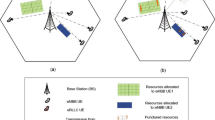Abstract
It has been known that adaptive modulation and coding (AMC) at the physical layer can be combined with a truncated automatic repeat request (ARQ) at the data link layer so as to maximize the spectral efficiency under prescribed delay and error performance constraint. In this paper, we consider the same joint design approach when incremental redundancy-based hybrid ARQ (IR-HARQ) is associated with an AMC design at the physical layer. The extensive simulation studies for predicting the progressive combining gain with each retransmission enables to evaluate the bandwidth efficiency that can be achieved by selecting a more aggressive modulation and coding rate set (MCS) at the expense of packet error rate in earlier transmissions. It has been demonstrated that the aggressive AMC design approach in association with IR-based truncated HARQ can improve bandwidth efficiency by 5.8 and 3.3 dB, as compared to the conservative AMC design approach with truncated HARQ and aggressive AMC design approach with truncated ARQ (i.e., without taking the progressive combining gain in HARQ into account), respectively.
Similar content being viewed by others
References
Goeckel D.L. (1999) Adaptive coding for time-varying channels using outdated fading estimates. IEEE Transactions on Communications 47: 844–855
Goldsmith A.J., Chua S.-G. (1998) Adaptive coded modulation for fading channels. IEEE Transactions on Communications 46: 595–602
Malkamaki E., Leib H. (2000) Performance of truncated type-II hybrid ARQ schemes with noisy feedback over block fading channels. IEEE Transactions on Communications 48: 1477–1487
Yang Q., Bhargava V.K. (1993) Delay and coding gain analysis of a truncated type-II hybrid ARQ protocol. IEEE Transactions on Vehicular Technology 42: 22–32
Liu Q., Zhou S., Giannakis G.B. (2004) Cross-layer combining of adaptive modulation and coding with truncated ARQ over wireless links. IEEE Transactions on Wireless Communication 3: 1746–1755
Chen, F., Su, L., Chen, M., & Yang, D. (2006). A Markov based method for modulation and coding scheme (MCS) with hybrid ARQ retransmission. In IFIP international conference on wireless and optical communications networks.
Huaping, F., Chen, F., & Tingjie, T. (2006). A threshold optimizing method based on Markov in AMC combined with HARQ. In International conference on wireless communications, networking and mobile computing.
Peng, X., Song, M., & Song, J. (2007). Cross-layer design for adaptive modulation and coding with hybrid ARQ. In International symposium on microwave, antenna, propagation and EMC technologies for wireless communications.
Kim, D., Jung, B. C., Lee, H., Sung, D. K., & Yoon, H. (2008). Optimal modulation and coding scheme selection in cellular networks with hybrid-ARQ error control. IEEE Transactions on Wireless Communications, 7(12, Part 2), 5195–5201.
Alouini M.-S., Goldsmith A.J. (2000) Adaptive modulation over Nakagami fading channels. Kluwer Journal on Wireless Communication 13(1–2): 119–143
Author information
Authors and Affiliations
Corresponding author
Rights and permissions
About this article
Cite this article
Kang, C.G., Park, S.H. & Kim, J.W. Design of Adaptive Modulation and Coding Scheme for Truncated Hybrid ARQ. Wireless Pers Commun 53, 269–280 (2010). https://doi.org/10.1007/s11277-009-9683-6
Received:
Accepted:
Published:
Issue Date:
DOI: https://doi.org/10.1007/s11277-009-9683-6




